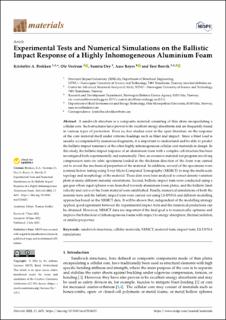| dc.description.abstract | A sandwich structure is a composite material consisting of thin skins encapsulating a cellular core. Such structures have proven to be excellent energy absorbents and are frequently found in various types of protection. Even so, few studies exist in the open literature on the response of the core material itself under extreme loadings such as blast and impact. Since a blast load is usually accompanied by numerous fragments, it is important to understand and be able to predict the ballistic impact resistance of the often highly inhomogeneous cellular core materials in design. In this study, the ballistic impact response of an aluminium foam with a complex cell structure has been investigated both experimentally and numerically. First, an extensive material test program involving compression tests on cubic specimens loaded in the thickness direction of the foam was carried out to reveal the mechanical properties of the material. In addition, several of the specimens were scanned before testing using X-ray Micro Computed Tomography (XRMCT) to map the multi-scale topology and morphology of the material. These data were later analysed to extract density-variation plots in many different material orientations. Second, ballistic impact tests were conducted using a gas gun where rigid spheres were launched towards aluminium foam plates, and the ballistic limit velocity and curve of the foam material were established. Finally, numerical simulations of both the material tests and the ballistic impact tests were carried out using LS-DYNA and different modelling approaches based on the XRMCT data. It will be shown that, independent of the modelling strategy applied, good agreement between the experimental impact tests and the numerical predictions can be obtained. However, XRMCT data are important if the final goal is to numerically optimise and improve the behaviour of inhomogeneous foams with respect to energy absorption, thermal isolation, or similar properties. | en_US |

